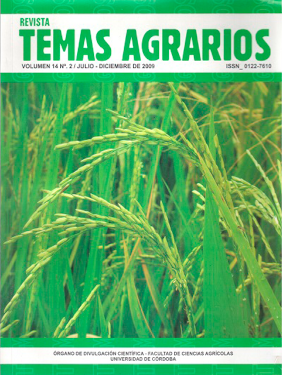Biologia Do Àcaro Predador Amblyseius Herbicolus Alimentado por Pólen e Pela Presa Tetranychus Urticae
Biology of the predatory Amblyseius herbicolus MITE (Acari: Phytoseiidae) feeds on pollen and on Tetranychus urticae
Cómo citar
Oliveira, H., Fadini, M., Rezende, D., Soto Giraldo, A., Girón Pérez, K., Aramendiz Tatis, H., & Pallini, A. (2009). Biologia Do Àcaro Predador Amblyseius Herbicolus Alimentado por Pólen e Pela Presa Tetranychus Urticae. Temas Agrarios, 14(2), 43-45. https://doi.org/10.21897/rta.v14i2.674
Dimensions
Licencia

Esta obra está bajo una licencia internacional Creative Commons Atribución-NoComercial 4.0.
Mostrar biografía de los autores
Visitas del artículo 973 | Visitas PDF
Descargas
Los datos de descarga todavía no están disponibles.
- Ali, F. 1998. Life tables of Phytoseiulus macropilis (Banks) (Gamasida: Phytoseiidae) at different temperatures. Experimental and Applied Acarology 22(8):335-342.
- Badii, M., Hernandez-Ortiz, E., Flores, A. y Landeros, J. 2004. Prey stage preference and functional response of Euseius hibisci to Tetranychus urticae (Acari: Phytoseiidae, Tetranychidae). Experimental and Applied Acarology 34(3):263-273.
- Bakker, F., Klein, M., Mesa, N. y Braun, A. 1993. Saturation deficit tolerance spectra of phytophagous mites and their phytoseiid predators on cassava. Experimental and Applied Acarology 17(2):97-113.
- García-Marí, F. y González-Zamora, J. 1999. Biological control of Tetranychus urticae (Acari: Tetranychidae) with naturally occurring predators in strawberry plantings in Valencia, Spain. Experimental and Applied Acarology 23(6):487–495.
- Helle, W. y Sabelis, M. 1985. Spider mites. Their biology, natural enemies and control, Elsevier, Amsterdam, 458p.
- Krips, O., Witul, A., Willems, P.y Dicke, M. 1998. Intrinsic rate of population increase of the spider mite Tetranychus urticae on the ornamental crop gerbera: intraspecific variation in host plant and herbivore. Entomologia Experimentalis et Applicata 89(26):159-168.
- McMurtry, J. y Croft, B. 1997. Life-styles of Phytoseiid mites and their roles in biological control. Annual Review of Entomology 42(1): 291-321.
- McMurtry, J., Huffaker, C. y Van de Vrie, M. 1970. Ecology of tetranychid mites and their natural enemies: a review. I. Tetranychid enemies: their biological characteres and the impact of spray pratices. Hilgardia 40(11): 331-390.
- Moraes, G., McMurtry, J., Denmark H. y Campos, C. 2004. A revised catalog of the mite family Phytoseiidae. Zootaxa 434:1- 494.
- Moraes, G. 2002. Controle biológico de ácaros fitófagos com predadores, p.225-237. In J.R.P.
- Parra, P.S.M. Botelho, B.S. Corrêa-Ferreira & J.M.S. Bento (eds.), Controle biológico no Brasil: Parasitóides e predadores. São Paulo, Manole, 635p.
- Moraes, G. 1991. Controle biológico de ácaros fitófagos. Inf. Agropec. 15:53-55.
- Opit, G., Nechols, J., Margolies, D. y Williams, K. 2005. Survival, horizontal distribution, and economics of releasing predatory mites (Acari: Phytoseiidae) using mechanical blowers. Biological Control 33(3): 344-351.
- Osborne, L., Ehler, L. y Nechols, J. 1985. Biological control of the twospotted spider mite in greenhouses. Bulletin 853, Institute of Food and Agricultural Services, University of Florida, Gainesville, 40p.
- Reis, P., Teodoro, A., Neto, P. y Silva, E. 2007. Life history of Amblyseius herbicolus (Chant) (Acari: Phytoseiidae) on coffee plants. Neotropropical Entomology. Apr. 36 (2):282-287
- Skirvin, D. y Williams, M. 1999. Differential effects of plant species on a mite pest (Tetranychus urticae) and its predator (Phytoseiulus persimilis): Implications for biological control. Experimental and Applied Acarology 23(2):497-512.
- Shih, C. y Huang, J. Functional responses of Amblyseius womersleyi preying on the kanzawa spider mite. En: Dusbabek, F. y Bkva, V. (Ed.). Modern Acarology, Academia, Prague and SPB Academic Publishing bv, The Hague. p481-486.
- Thongtab, T., Chandrapatya, A. y Baker, G. 2001. Biology and efficacy of the predatory mite, Amblyseius longispinosus (Evans) (Acari, Phytoseiidae) as a biological control agent of Eotetranychus cendanai Rimando (Acari, Tetranychidae). J. Appl. Entomol. 125(2):543-549.
- Van Houten, Van Rijn, P., Tanigoshi, L., Van Stratum, P. y Bruin J. 1995. Pre-selection of predatory mites to improve year-round biological control ofwestern flower thrips in greenhouse crops. Entomol. Exp. Appl. 74(3):225-234.
- Zhang, Z. y Sanderson, J. 1995. Twospotted spider mite (Acari: Tetranychidae) and Phytoseiulus persimilis (Acari: Phytoseiidae) on greenhouse roses: Spatial distribution and predator efficacy. J. Econ. Entomol. 88 (2): 352-357.




















